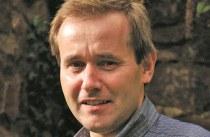A collaboration between Professor Julian Paton (School of Physiology and Pharmacology, University of Bristol) and Dr Alain Nogaret (Department of Physics, University of Bath) has yielded a new kind of artificial neural network which can be bolted onto existing devices to produce a new type of cardiac pacemaker. This could transform the lives of people requiring an implant to restore heart rhythm, it and it may prove effective at reversing cardiac dysfunction in heart failure.
The body’s natural regulation of heartbeat is in phase with a person’s breathing or respiratory cycle. For example, the heart slows down during expiration (breathing out) and speeds up during inspiration (breathing in). This is known as respiratory sinus arrhythmia (RSA). The loss of RSA causes a variable heart rate and is an early indicator of heart failure.
Previous studies have shown that RSA is an energy-saving mechanism for the heart. The research team proposed that RSA could help a failing heart by optimising cardiac output (volume of blood pumped out by the heart) and saving cardiac energy. They aimed to test this in rats with heart failure using an artificial neural network or a central pattern generator (CPG) to reinstate RSA.
The project began promisingly, but the team needed additional pilot data to apply for a British Heart Foundation (BHF) New Horizons award. An EBI TRACK award, which supports health-related research that has translational or commercial potential, made this possible.
The researchers had already developed a CPG that could be miniaturised in silicon for implantation. Conventional implants sense acceleration of movement and temperature but cannot respond to body state; the CPG, on the other hand, responds to incoming physiological information and is linked to respiration. It is also analogue instead of digital, which means it operates in real time using a fraction of the power of conventional digital devices.
The team proposed that phased stimulation of the vagal nerve by the CPG would improve cardiac output and coronary flow (the flow of blood to the heart) in rats with heart failure. The vagal nerve regulates multiple body functions (including heart rate) and vagal nerve stimulation is being trialled by Boston Scientific as a therapy for human heart failure. The researchers expected that vagal nerve stimulation by the CPG would allow heart rate to be modulated by respiratory rate, and naturally paced up as breathing increased, for example due to exertion, exercise or altitude.
For the purposes of the study they tested this out in healthy rats and in rats with heart failure. This showed that using the CPG to stimulate the vagal nerve could enhance RSA in healthy rats. Importantly, it also demonstrated that reinstating RSA in heart failure rats increased the volume of blood pumped per beat, which is an important determinant of cardiac output.
However, the study also showed that the technique to determine blood flow in the small vessels of tissues in rats was not sensitive enough to detect improvement in coronary flow with RSA. This showed a need for further studies using an animal larger than a rat, where the flow probe could to be placed directly on the coronary artery to give an instantaneous beat-by-beat recording of coronary blood flow and its changes during RSA.
Pilot data from the study was enough to secure the BHF New Horizons grant, and this led to an Innovate UK award to set up a spin-out company, Ceryx Medical. The company will assess the long-term benefits of a novel analogue device that will reinstate natural rhythm to the heart in disease states where it is lost such as heart failure. The research team has also linked up with Dr Edward Duncan from the British Heart Institute to test the effects of RSA pacing on cardiac outputs in heart failure patients.
